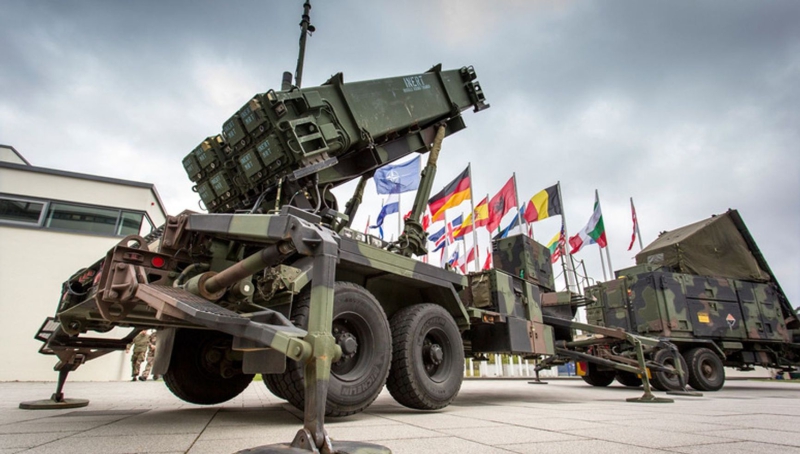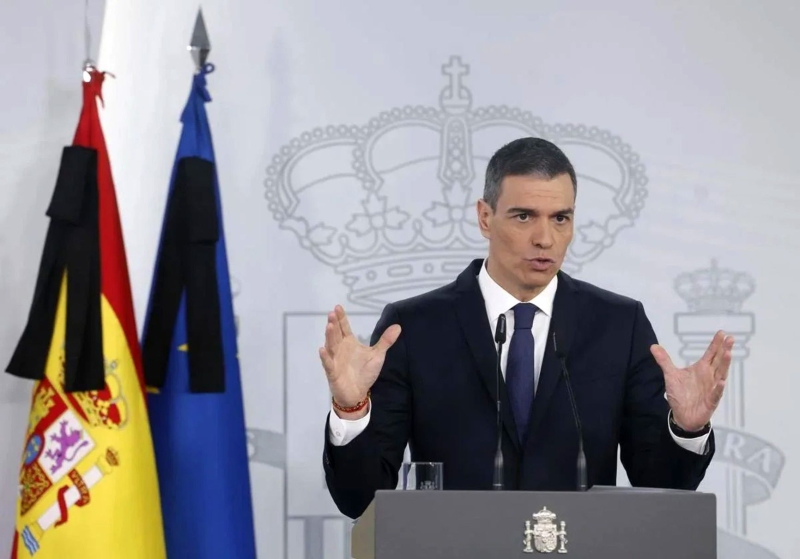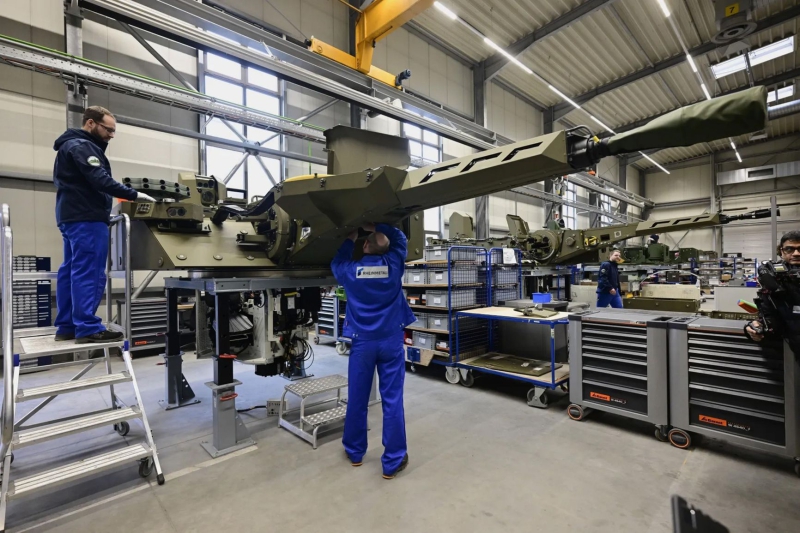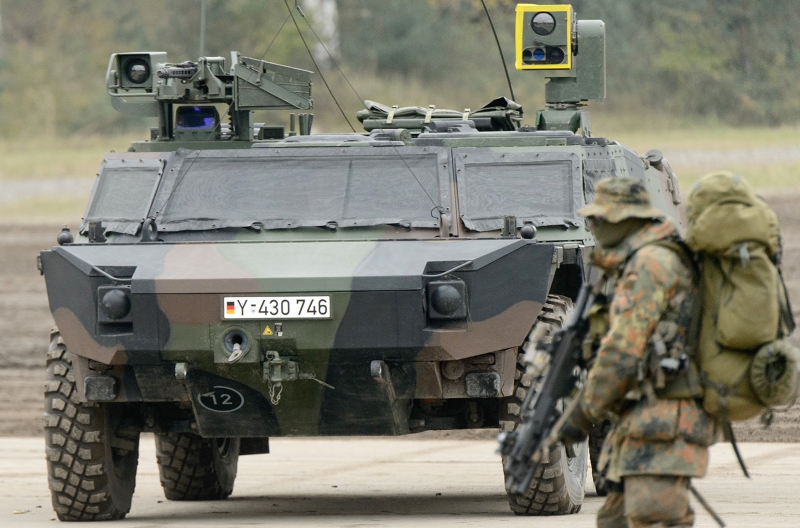Global Look Press / Sebastian Gollnow
At the recent NATO summit in The Hague, alliance members approved a new defense spending target of 5% of GDP by 2035 — a pledge endorsed by all 32 member states. Europe is entering a new chapter in its history, preparing to rearm as the threat from Russia and the cooling of relations with the United States combine to compel the continent to pursue strategic autonomy. The new doctrine promises economic growth and new jobs, but in the long run may bring debt and austerity.
European leaders have agreed to significantly bolster defense spending, convinced that Europe can no longer “forever rely on America” — especially amid growing tensions with the Trump administration. Public opinion has also shifted: a Eurobarometer survey conducted in the fall of 2024 found that a 33% plurality named “security and defense” as a priority area for “the EU [to] take measures in.” Security concerns were most visible among respondents in Finland, Poland, and the Baltic states (expressed by nearly 50%), and less so among citizens of countries more distant from Russia, such as Spain or Greece.
Such concerns are only being exacerbated as the U.S. increasingly drifts away from its traditional role as Europe’s security guarantor, prompting NATO allies to boost investment in the defense sector. Washington's new stance — one Brussels has come to share — is that the EU must “grow up” and take responsibility for its own security. This geopolitical pressure, combined with growing public support for Ukraine, has created a powerful momentum for rearmament on the continent.
Washington's new stance — one Brussels has come to share — is that the EU must “grow up” and take responsibility for its own security
In mid-2024, the Commission stated that “additional defense investments of around EUR 500 billion are needed over the next decade” in order to replenish depleted stocks and close capability gaps.
Then, in March 2025, European Commission President Ursula von der Leyen presented the Readiness 2030 initiative (formerly known as “ReArm Europe”) to mobilize nearly €800 billion in additional spending. NATO intelligence does not rule out that Russia could start a war in Europe again within the next three to five years, which is why the plan targets the year 2030.
The plan published by the European Commission reinforces von der Leyen’s warning about growing threats, noting that even if all European NATO members eventually reach a defense spending level of 2% of GDP, Europe would add only €60 billion, which is nowhere near enough. Therefore, the Commission officially calls for around €500 billion in additional funds over the next decade.
Most of the responsibility will fall on national governments. The EU plans to encourage states to increase defense spending by providing loans through a new €150 billion mechanism called the Security and Defence for Europe (SAFE) initiative, mainly for specific projects such as missile defense, drones, cybersecurity systems, or enhancing troop mobility.

To assist national budgets, the Commission proposes activating Stability and Growth Pact provisions for four years (2025–2028), allowing each country to increase defense spending by 1.5% of GDP annually, regardless of the permissible budget deficit. In practice, this should create a €650 billion “piggy bank” across the EU. Additionally, the European Investment Bank is expected to increase financing for defense projects, and the EU will aim to coordinate and consolidate procurement to ensure that member states spend “better together and invest more European.”
The revival of European strategic autonomy is presented as a complement to NATO, not a replacement of the alliance. In other words, European armies should be able to stand firmly on their own two feet, even as they continue to train, arm, and operate alongside American forces.
The European Union emphasizes that strengthening its members’ militaries will boost the EU’s contribution to NATO as a whole. “As 450 million Europeans, we should not ask, we should not cry for 340 million Americans to defend us,” said Andrius Kubilius, the first European Commissioner for Defense and Space.
Analysts at the International Institute for Strategic Studies (IISS) agree that the EU’s contribution will ultimately strengthen the bloc.
SAFE loans from the European Union are intended to be used for air and missile defense, artillery systems, ammunition, unmanned aerial vehicles (and counter-drone measures), strategic assets such as cyber and satellite communications, and infrastructure development. The description identifies “500 hot-spot projects,” including the expansion of key railway tunnels, the strengthening of bridges, and the enlargement of ports and airports — all aimed at ensuring the rapid movement of troops and equipment across Europe.
Another important area of focus is the development of a domestic defense industry. Brussels insists that any new equipment must be manufactured in Europe, with the majority of components — at least 65% of the final product — sourced from EEA countries or Ukraine.
Any new military equipment must be sourced from Europe
EU officials plan to encourage the consolidation of the defense sector, reducing the multitude of small companies to a handful of strong ones. They also foresee increased state aid for arms manufacturers, streamlined bureaucracy (“Defense Omnibus Simplification”), and the strengthening of the single market for arms procurement. In practice, this means growth in joint ventures and cross-border partnerships. Defense analysts expect a surge in pan-European projects and possibly corporate mergers.
Europe must build up stocks of ammunition and spare parts, jointly develop new technologies, and support factory operations. The Commission explicitly mentions replenishing ammunition supplied to Ukraine along with addressing “lost opportunities” caused by years of underfunding. The €800 billion plan covers new weapons and equipment (tanks, aircraft, missiles, ammunition), the modernization of military infrastructure, and the expansion of production capacities. This will require forging new partnerships between EU governments and their armed forces — for example, a loan to build a missile production plant will only be granted if the project involves at least two countries.
As a form of government investment, defense spending generally stimulates the economy in the short term — just like most other industrial incentives. European researchers have estimated that putting additional funds into the production of “guns” will lead to a modest GDP growth of around 0.1–0.2% in 2026–2027, especially if most of the money stays within Europe. A Goldman Sachs study forecasts a positive multiplier effect (with a coefficient of 0.5), meaning that every €100 spent on defense will increase overall GDP by about €50, provided that the majority of the funds are spent on domestic production.
The Kiel Institute for the World Economy emphasizes that if European countries increase defense spending from around 2% up to a level of 3.5% of GDP and focus on purchasing high-tech, domestically sourced equipment, GDP could grow by 0.9–1.5% annually. Moreover, military investments are widely believed to stimulate innovation — in today’s world, that means progress in the fields of artificial intelligence, materials science, and cybersecurity, among others.
Military investments are believed to stimulate innovation — in artificial intelligence, materials science, cybersecurity, or other related fields
At the same time, the 3% target is gradually fading into the past. As early as January 2025, Trump stated that Washington’s NATO allies should increase defense spending to 5%. Initially, the reaction in Europe was mixed: while countries like Sweden and Estonia supported the call, those like Germany were less enthusiastic. However, the situation has since changed. Boris Pistorius, Germany’s Defense Minister, indicated that Berlin is ready to commit to 5% spending. In early June, endorsement came from 14 other European countries — mostly from Northern, Eastern, and Central Europe.
Consensus has also been reached within NATO. At the Summit on June 25, alliance members adopted a new defense spending target of 5% of GDP by 2035, overcoming objections from Spain. Spanish Prime Minister Pedro Sánchez initially blocked an earlier version of the text, stating that committing to the higher target would be unreasonable and counterproductive.
Spain places special emphasis on short-term benefits. Its economy is showing steady growth (around 3.2% in 2024) and record tax revenues. Madrid has pledged an additional €10.5 billion this year in order to reach NATO’s 2% of GDP target. The increased spending will go to Spanish shipyards, aircraft factories, and electronics companies. Prime Minister Sánchez insists this will help create up to 100,000 new jobs, and the Spanish government maintains that it can finance these expenditures without cutting pensions or healthcare spending, as growth and tax revenues remain high.

European defense industry players emphasize that even if the war in Ukraine ends, demand for new weapons will remain high. In short, Europe will continue to rearm. Kaja Kallas, the Head of the European External Action Service (EEAS), noted that weapons production in Russia is “in full war mode,” which is why Europe needs its own long-term armaments plan.
Weapons production in Russia is “in full war mode,” so Europe needs its own long-term armaments plan
Major weapons manufacturers are investing in order to meet new demand. Rheinmetall plans to double ammunition production and build new factories, warning that after several months of war, European arsenals are practically depleted. The company’s CEO, Armin Papperger, says the order list is growing. Increasing Germany’s defense spending from 2% of GDP up to the 2.5–3% range would mean an additional €60–70 billion per year.
Papperger’s colleague and competitor Micael Johansson, the CEO of the Swedish defense and security company Saab, also believes that Europe is lagging behind. Johansson urges European countries to harmonize their requirements and purchase weapons in large batches, rather than developing them individually for each country.
Johansson sees a growing willingness among EU countries to share technologies and build sovereign joint capabilities. In Italy, Leonardo CEO Roberto Cingolani welcomes this trend, saying that Trump’s call for a “strong Europe” aligns with Leonardo’s commitment towards cross-border defense projects.
However, the all-you-can-eat feast for the defense industry comes with inevitable trade-offs. After all, €800 billion doesn’t come out of nowhere. The same Commission simulations that forecast moderate GDP growth also predict a rise in public debt, as additional defense spending could drive up budget deficits unless offset by new revenues or cuts in other areas. Ratings agency Fitch warns that without additional measures, the EU’s budget deficit could surge from below 3% to around 6% of GDP within a few years.
Several major economies are already heavily indebted. Italy and Greece entered this new era of military buildup with debt-to-GDP ratios of around 150% and 200%, respectively. Fitch notes that these countries currently spend only about 2% of their GDP on defense, and a rise to 3–4% could result in significant deficits, potentially leading to a downgrade in EU countries’ credit ratings. Germany and France will likely be able to afford additional spending (both are planning to move toward 3%), but countries like Italy and Greece face much tighter budget constraints.
Moreover, some economic and labor organizations warn that channeling public funds into armaments could lead to cuts in social spending and job creation programs. Certain trade unions are particularly outraged by plans to use money from the EU’s cohesion funds — roughly €400 billion — to strengthen the defense of “frontline” states.
The European Commission’s strategy attempts to address this issue. Defense investments are framed as a driver of economic growth, promising new factory jobs and increased innovation. However, trade unions and skeptical politicians still fear that social projects could be sacrificed. Indeed, simply redirecting existing EU funds toward defense could undermine other priorities and trigger a painful political backlash — potentially strengthening fringe, mostly far-right parties. The Insider discussed this effect in an earlier article on the “right turn” of previously centrist political forces.
Redirecting existing EU funds toward defense could strengthen fringe, predominantly far-right parties
The European Commission’s current measures offer only temporary relief. From 2025 to 2028, defense spending will be excluded from the EU’s deficit rules, but after that, countries will be required to rebalance their budgets. Economists warn that high debt levels also mean high interest rates, which could force future governments to raise taxes or cut pensions.
While admitting the necessity of increasing military budgets, Klaas Knot, a European Central Bank board member and head of the Dutch central bank, stated that it will lead to higher borrowing and complicate both inflation forecasts and monetary policy planning.
There are also potential medium-term challenges. An IMF report on “long-term spending pressures” in Europe warns that providing for aging populations, climate-related needs, and defense requirements could collectively hike public spending by 6–8% of GDP by 2050.
The European Central Bank believes that fulfilling these plans will require issuing significantly more government bonds, a move that could test the market’s capacity to absorb such a large amount of debt. The greatest risks lie with countries that already have high debt levels, most notably Greece and Italy.
There are also political objections. Slovak Prime Minister Robert Fico traditionally opposes increased defense spending, despite his country’s official favorable stance. This time, he took an even more radical approach, suggesting that “neutrality would suit Slovakia very well.” Problems are also expected from Hungary, where Viktor Orbán has consistently fought against raising defense budgets and often places obstacles in the way of allies’ who seek to increase their military outlays. Just two days before the recent NATO summit, Hungary and Slovakia blocked a European sanctions package against Russia — not for the first time.
As always, the ultimate effect depends less on the plan itself and more on its implementation. The European defense sector is well prepared for new investments, says economist Guntram Wolff from the Belgian think tank Bruegel. Production capacities are sufficient, and they are capable of undergoing further growth. What concerns experts is bureaucratic barriers and a low level of market consolidation: combined, these two factors could lead to delays in deliveries.

However, if spending is focused on equipment produced in Europe, and if governments are willing to cooperate productively with the private sector, then the benefits of boosting the continent’s defense sectors will be much greater than the cost. Conversely, if the majority of new expenditures go toward imports, increase deficits, or lead to cuts in social investments, the benefits will be significantly reduced.
European plans could be hindered by trade wars between Western countries. Trump's recent announcement of 25% tariffs on steel and aluminum and 20% on many goods from the EU threatens to slow growth and ramp up costs for European businesses. The EU estimates that these duties will affect exports worth around €26 billion, and Brussels has responded with similar measures on American imports totaling $28 billion.
In the defense industry, rising prices for metals will increase production costs for armored vehicles, shipbuilding, and aircraft. This uncertainty is already impacting investments. As Andrea Nahles, head of the German Federal Employment Agency, warned, “The erratic trade policy of the USA is a burden on the German labor market” and could result in the loss of around 90,000 jobs within a year.
Trade shocks also threaten overall economic growth. Analysts at the European Central Bank expected GDP to increase by only around 0.9% in 2025, even before the latest trade measures. Derek Bisaccio, a defense market analyst, explains that governments are already struggling with an economic slowdown and large fiscal imbalances, making it difficult to further increase defense budgets.
A global trade war could trigger price increases across the board: on energy, raw materials, and electronics — all of which are crucial for weapons systems. And the European defense sector may face competition from cheaper Asian imports, putting pressure on the continent’s arms manufacturers. Tariff barriers and disruptions in supply chains could fuel inflation, higher interest rates, and budget cuts, thereby limiting the ability to finance military programs.
Therefore, if Europe fails to restore a stable trade environment, its defense goals will be put at risk. The EU plan encourages procurement from partners to share costs. However, if geopolitical upheaval leads to new sanctions or trade barriers, the anticipated economic benefits may not materialize.
Readiness 2030 may only be the beginning. NATO representatives warn that the previous target of 2% of GDP for defense spending is no longer sufficient. Secretary General Mark Rutte stated that new capacity-building plans might require more than 3%. U.S. Secretary of Defense Pete Hegseth and some of his counterparts — such as Germany’s Defense Minister Boris Pistorius — consider NATO’s existing 2% GDP defense guideline outdated, hinting that a more appropriate benchmark might now be 5%.
This does not render the current program useless. The goals of Readiness 2030 include not only increasing spending but also using it wisely through joint procurement and innovation, which, according to Rutte, can reduce the total funds needed. Incidentally, this is why the EU plan explicitly issues calls to “buy European” and pool projects so that every euro delivers more value.
Ultimately, EU leadership expects that the benefits in security will justify the expenditures. Politicians are unanimous: collective peace and stability are worth it. For ordinary citizens, the question will be whether the short-term economic benefits — such as jobs and technology — outweigh the long-term risks. It will be up to policymakers to find a balance between the economic growth opportunities offered by high-tech military programs and the potential budgetary burden, so that social needs are not compromised in pursuit of protecting populations from an external threat.

